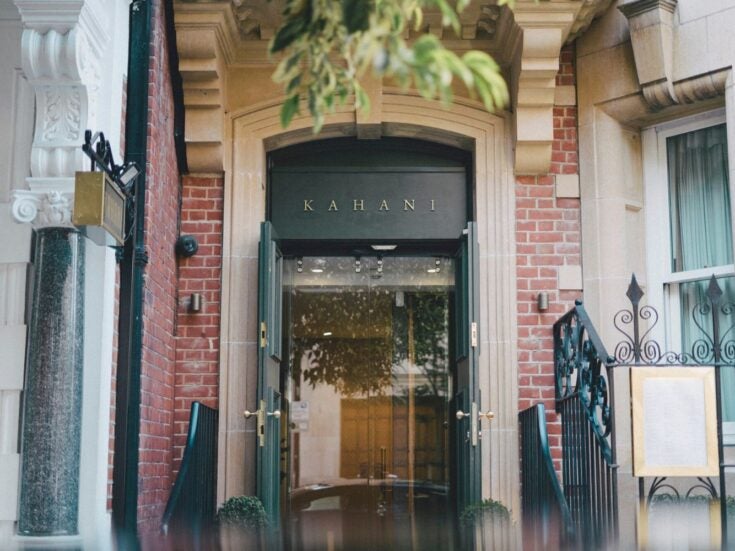
Chrysan near Liverpool Street is the new venture from the brains behind the Hakkasan Group and Yoshihiro Murata, holder of seven Michelin stars in Japan. Tim Mawn, head chef at George and a devoted Japanophile, is impressed – but not by the cauliflower custard
SOMETIMES WORKING AS a chef has its rare benefits. One of those for me recently was being invited to the soft opening of Chrysan restaurant, an opportunity I simply couldn’t turn down.
This is a venture headed by the people behind the Hakkasan Group and the Japanese national treasure known as Yoshihiro Murata, who, while holding seven Michelin stars in only three restaurants in his native country, is also the chairman of the Japanese culinary academy, runs a successful high-end food product company and is a constant presence on Japanese television.
For those in the industry, a soft opening is the time to finally iron out any menu or service issues, before the expectant public, rapacious food critics and anonymous bloggers descend.
This is a moment when things are clearly not at their best (I would recommend a three-month period before any visit, even to a cobblers), but with all this in mind, for me it would be a perfect opportunity to catch a concept at its birth, among other invited industry chefs who can spot the difference between teething problems and true intentions. We just want to savour this genius’s sublime kaiseki creations – oh, and yes it was free food too.

Pictured left: Yoshihiro Murata, the chef-brains behind Chrysan
As a chef who has spent the last seven years travelling to Japan, and has eaten in all of Murata’s restaurants, I feel I have an understanding of his approach to food, which is a modern interpretation of his forefathers’ traditional and intensely seasonal Kaiseki cuisine: a step into precise, delicate, aesthetic works on a plate, steeped in traditional philosophy and understanding of nature, so I was deeply intrigued to see what this would mean in a foreign country.
KAISEKI IS A deeply Japanese style of cooking that relies solely on regional, seasonal produce, so the fundamental question is, How can this be translated to the business district of a city 5944.037 miles away? With my own hand-made chopsticks in the pocket, we headed off.
The setting of the restaurant reminded me very much of the business district of Tokyo, Ginza, a fitting home, all steel, high-rise and furious modern banking. We were met by an army of greeters and formally introduced to the traditionally-clad wife of Murata.
On the way in to the dining room we saw the great man himself, at whom I fired off a stream of completely unacceptable Japanese, only for him to tell my wife he didn’t understand a word. So far, so normal – just like being in Japan for me.

The dining room is sleek, as a mix of traditional and modern design the very antithesis of Japanese ideology. The very spacious kitchen can be viewed through a series of thin glass panels, unobtrusive, but still with an essence of the kitchen and dining room being connected, an important design feature in any establishment serving raw fish.
We were offered a six-course kaiseki tasting menu, which we were told would take around two hours to enjoy. At this early stage it was clear that the front of house were confidently well drilled on both points of service and menu knowledge, no mean feat, considering they still had a full three days before going live.
After customary offerings of wine and champagne, we were given a small shot from an iron kettle into a wooden thimble of sake with pineapple and yuzu, a perfect palette cleanser. Next came a canapé of puréed tuna on crisp blocks of flattened rice cake, and salmon roe, which was delicately pleasing, with what one can only describe as having a texture similar to crisp pigs’ skin.
Then came a whole satsuma, sliced in half, with the bottom half filled with home-made silken tofu with a glaze of yuzu-impregnated sauce. This is a technique I have only seen from a kitchen in London once, at Hedone in Chiswick. It is a warm, delicate baked savoury custard which to most European palates is confusing to say the least, but something that needs to be appreciated for its delicacy, not its immediacy. It is purely about comfort and mouth-feel.
Judging by my fellow diners, they were definitely in the confused bracket, but this sort of chawanmushi (cooked savoury custard) is a staple of Japanese cooking. ‘Chawanmushi’ means ‘steamed in a tea bowl’, but this time it was very cleverly steamed in the hull of a citrus fruit. The slight bitterness from the skin was an unexpected pervasion.
NEXT CAME A series of perfectly sliced and served sashimi, paired with sauces which were probably designed with the British palate in mind, a little too powerful for most aficionados: a bit sweet here, a little spicy there, slightly masking the delicate flavours of the fish.
Then the main courses: a tranche of smoked salmon with a spinach puree and egg yolk sauce. The fish was texturally like room-temperature butter, I can only imagine this must have been cooked in a water bath; the three other chefs on my table agreed. It is a great dish which I shall no doubt selfishly use for my own purposes.
At the same time ceramic pots holding candles were placed on the table. This could mean only one thing: nabe! This is a communal dish which, in effect, is a stew bowl set in the middle of the table, to which participants can add and take various ingredients at their will, a most pleasurable and sociable way of eating one can imagine.

I am sternly told by my wife that every house in Japan has a nabe pot. Ours had, what can only be described as a cloud of candy floss sitting on the top, on which the waiter drizzled soy sauce causing it to melt into the bowl, thus replacing the normal sugar content of the stock, but with added theatre (pictured above).
In the bowl were chunks of leek and diced rib of beef, which we were told had been previously cooked in a sous vide water bath, and a dashi stock. The dish itself was very sweet, a little too cloying in fact, but with a little tweaking, this could be a signature dish, and probably well copied in the near future.
DESSERTS WERE A selection of unctuous apple tatin, cucumber water and sorbet, which were a lesson in delicacy and aesthetic gymnastics. The only down point to the finale was a cauliflower panna cotta. At this point all heads on the table revealed a slightly shocked look (out of six people seated at the table, four were well-eaten, well-travelled chefs).
With an open mind, esoteric ingredients in the right hands can be a revolutionary experience, but as all lovers of cauliflower (and young children) know, when cooking this brassica, it is impossible to escape the slight whiff of a Labrador’s fart, and this charming characteristic had not escaped this elegant-looking dessert. Needless to say, on return I shall not order this – only perhaps if I am dining with a mortal enemy, or if I ever get the chance to dine with wicked chef Gerald Samper, novelist James Hamilton Paterson’s creation, who would no doubt die a quick death of the greenest of envies.
Throughout this lunch, a succession of the great and good of London’s chefs were present, so for an anonymous non-celebrity, it was a rare treat on many levels. I shall be returning after the three-month bed-in period to see this operation at its peak. However, as a cauliflower-lover, and previous Labrador owner, there will be one thing that won’t be on my bill.
Chrysan
Broadgate West
1 Snowden Street
Tim Mawn is head chef at George
Don’t miss out on the best of Spear’s articles – sign up to the Spear’s weekly newsletter
[related_companies]





